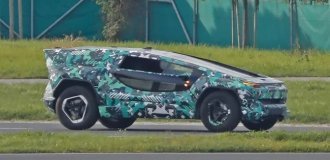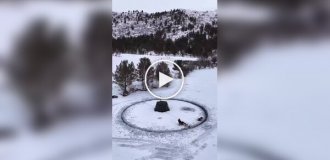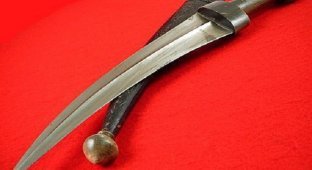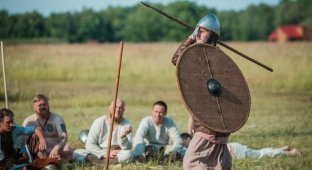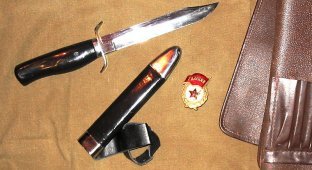I present to you a small selection of armor and weapons. I warn the lazy people at once there are not just a lot of letters, but a lot. For aesthetes, I want to add - it has not been read or verified.

A saber is a piercing-cutting bladed weapon, with a long curved single-edged blade and a hilt. The Russian word "saber" probably comes from Hungarian. szablya - “to cut.” Both the Polish szabla and the German Sabel, from which the French and English word sabre are derived, probably come from Hungarian.

A distinctive feature of the sabers is that their handle in relation to the blade was inclined (5-8°) forward. This was determined by the fact that sabers have a center of gravity located behind the butt. At a considerable distance from the hilt. And the axis of the handle was oriented precisely towards the center of gravity of the weapon. The saber blade, as a rule, is single-edged (in some cases with a one-and-a-half sharpening) and has a characteristic bend towards the butt. The bending of the blade and the displacement of the handle relative to the blade gives the chopping blow cutting properties, which significantly increases its effectiveness. When struck, the saber slides relative to the object being struck. This is especially important since the slash is always delivered in a circular path. In addition, striking at an angle to the target surface increased the pressure created. An increase in curvature leads to an increase in cutting ability, but at the same time to a weakening of chopping properties. This feature of the saber was most effective when using blades made of hard steels, which had high elasticity and toughness. As a result, the saber causes more serious damage than a sword or broadsword of the same mass. Often the end of the saber was double-edged by 10-20 cm, which increased its piercing properties. But with a large curvature, when a piercing blow becomes impossible, the tip of the blade sometimes was not even sharpened.


The main parameters of a saber are the length of the blade, defined as the length of the axis drawn from the tip to the point where the blade (or heel) ends and the tang begins. The length of the perpendicular dropped from the highest point of the blade's bend to this axis determines the curvature. Other important parameters are the distance from the tip to the end of the tang and the total length of the saber with the hilt, as well as the width of the blade and the thickness at the butt.
The saber appeared in the 7th century among the Turkic peoples, as a result of a modification of the broadsword. Single-edged broadswords in mounted combat had an advantage over double-edged swords due to their lighter weight, and also had a technological advantage. The appearance of a bend in the blade, small at first, made them sabers. Since the mid-7th century they have been known in Altai, since the mid-8th century in the Khazar Khaganate and spread among the nomads of Eastern Europe. The first sabers were an attribute of noble warriors and therefore, as a rule, were inlaid with gold and silver. The blades were produced using complex multilayer technologies, also typical for expensive swords, which involved welding iron and steel plates. In the 12th - 13th centuries, sabers became more widespread weapons, and therefore their technology became simpler. Most blades were now produced by welding on a steel blade or by cementing a solid iron strip. Since the 12th century, sabers began to be made from carburized blanks, which, as a result of special repeated hardening, received an ideal combination of viscosity and hardness, and the edge of the blade was especially hard.

At the end of the 9th century, sabers from nomads came to Rus'. Since the 11th century in southern Rus', sabers have become no less important weapons than swords. In the north they reach as far as Minsk, Novgorod and Suzdal Opolye, but there they are not so widespread. The length of the saber blade is 92–120 cm, with a blade length of 80–105 cm, the curvature is up to 4.5–5.5 cm, the average width is 3.5–3.8 cm; and sometimes the curvature reached 7 - 9 cm, and the width 4.4 cm. The weight of the sabers ranged from 0.4 to 1.5 kg (although there were also heavy sabers weighing up to 2.6 kg). The design of the saber handle was lighter than that of the sword. Its pommel was usually equipped with a ring for attaching a lanyard. At first, straight crosses with spherical crowns at the ends were common, which then curved downward. But then diamond-shaped crosses about 13 cm long with extensions at the ends become widespread. Such crosshairs increased the strength of the structure.
In the 10th-11th centuries, sabers appeared in the Arab world, but at first they did not become so widespread there, experiencing competition from the usual straight bladed weapons. Since the 12th century they have become more widespread in Iran, Anatolia, Egypt and the Caucasus. But only in the 13th century did sabers begin to replace broadswords in Islamic countries. The Mongol invasion played a big role here. At the same time they end up in India.


In the 14th century, elman (increasing the thickness of the blade at the tip) became widespread on the saber, after which the saber finally acquired the properties of a chopping weapon. And from the 15th-16th centuries, two main types of Islamic sabers emerged: narrow and long shamshirs of significant curvature, characteristic of Iran and belonging to the type of light sabers. On which sabers with a blade without elmani are more often found, and a small thin handle has a small head and a straight long cross. The Shamsher became the main type of saber for the entire Muslim region from Morocco to Pakistan. And shorter and wider kilics became the main model of the Turkish saber. It was a wide, heavy blade with less curvature, with a yelman and a sharp bend in the handle. Its handle is massive, made of bone or horn, thickening towards a large, bent back head and a long, straight cross. A lightweight version of the Turkish saber has a Persian-type blade, with a sharp bend and the absence of elmani. In Europe, the Polish-Hungarian saber was formed, narrow and long, but with less curvature. European sabers typically had a slight curve to the blade to allow forward cuts, a relatively heavy weight, and a closed guard to provide a strong but uniform grip. On the other hand, in Asia, sabers were forged with blades of not only diverse, but sometimes bizarre shapes, which, however, were the fruit not so much of a desire for originality as of a desire to make the most of the cutting properties of a Damascus blade with a microsaw. After all, although sabers were conceived as a chopping and, in part, piercing weapon, the presence of a microsaw on the blade made the cutting blow especially effective for them - only with such a blow the enemy almost fell apart in half. Therefore, in some cases, Damascus blades were adapted to this and only this blow.

During Napoleon's Egyptian campaign in 1798-1801, the French appreciated local sabers, after which they, and under the influence of French fashion, spread throughout Europe, Mamluk-type sabers. These sabers became standard weapons in Europe and the USA. In Russia, based on French models, infantry officer sabers of the 1826 model and dragoon sabers of the 1841 model were introduced. As a result, in the 19th century, sabers were used in all types of troops. Dragoons, hussars, and in some cases cuirassiers were armed with heavy cavalry sabers, while lancers and Russian irregular cavalry were armed with light ones. The navy used massive cutlasses. A variety of designs were also common in the infantry. At this time, even Turkish and Japanese sabers began to be made according to European models. True, trying to get rid of the inherent shortcomings of European sabers.

For example, one feature of European sabers is that their handles, as a rule, are covered with various grooves, and even wrapped in wire, again supposedly for ease of holding the weapon. In good oriental blades, the opposite is true: their handles are absolutely smooth - made of horn, ivory, hard wood, often covered with suede for ease of holding. This is understandable - experienced fighters practiced with a saber for several hours a day, and the hilts with scars would quickly cut the palm into blood.

Moreover, in pursuit of mass production and cheapness, European craftsmen completely neglected the shape of the cross-section of the blade. In most European samples it has the shape of a wedge, and in some the butt was even thickened, as, for example, in Russian sabers of the early 19th century. As a result, the further the blade penetrates into the flesh, the greater the resistance. In eastern blades, the greatest thickening of the blade is located closer to the blade, and the entire part of the blade behind this thickening, upon impact, no longer encounters resistance. The fullers on the blade increase bending resistance and reduce the weight of the weapon. But on eastern blades, all the corners of the fullers are rounded, and on European ones, both the fullers themselves and the butt have sharply defined corners, which, upon impact, delay the penetration of the blade into the body.

Another stumbling block is the weight of the weapon. Traditionally in Europe it was believed that the heavier the blade, the more effective it is in battle - just remember the legendary two-handed swords. Europeans disparagingly called eastern sabers lightweight. But the eastern gunsmiths turned out to be more right - after all, the force of an impact is proportional to the mass and the square of the speed. Therefore, it is much more effective to increase the speed of impact, which is higher for lighter eastern blades. In addition to increasing speed, lighter blades made it possible to perform fencing tricks that combat units with heavy sabers could not even dream of. In particular, participants in the Russian-Caucasian wars noted that while the Russian rider was swinging a heavy saber, the Caucasian warrior managed to strike the elbow area from below and then deliver a fatal blow to the disarmed enemy.

To increase the force of the blow, the part of the blade that strikes must be heavier than all other parts of the saber, therefore, the center of gravity must be shifted as much as possible towards the tip. The part of the blade adjacent to the handle serves solely to transmit the force of the blow - in an ax this role is played by the ax handle. Therefore, it is not at all necessary to make it the same width and thickness as the rest of the blade. Nevertheless, European blades are made almost the same width along the entire length, sometimes even widening towards the hilt. Eastern curved sabers, on the contrary, widen towards the end, tapering towards the hilt. All this for one purpose - to give the working part of the blade maximum weight and lighten the rest. The center of gravity should not be confused with the center of impact, often indicated on eastern blades by a special notch on the butt; in the Russian saber of the 1881 model, the fullers end in this place. When the direction of impact passes through this point, the hand does not receive any shock.

Damascus sabers were especially valued, but they were expensive due to the complexity of production and the large waste of metal - a simple saber had sufficient strength, but was much cheaper. From the second half of the 16th century, sabers from converted steel began to be produced in Europe. European blades never equaled the quality of Asian ones, but due to their cheapness in the 17th - 19th centuries they were willingly purchased even in India. However, the best and most expensive, and therefore rare, were damask sabers. For example, in the mid-17th century in Rus', an imported saber strip made of Persian steel cost 3-4 rubles, while a Tula saber cost no more than 60 kopecks. And sabers were needed in Rus'. Thus, merchants in Russia were required to wear sabers in formal dress.


In the European infantry among the Landsknechts, the two-handed Grand Messer saber was in circulation, which appeared in the 15th century in Hungary, and was used mainly against horsemen, but very quickly disappeared from use, giving way to the ax. Two-handed Chinese (no-dachi, shuangshoudao, etc.) and Arab sabers were used for the same purposes. But just as quickly they were withdrawn from service.

A boarding saber (English cutlass) is a chopping or stabbing bladed weapon, with a blade shortened to 60 cm. It looks like a not long, but wide saber, with a straight or slightly curved blade and a well-developed basket-type guard. The hilt was designed to provide almost complete palm protection in combat. It was used by sailors and pirates during boarding battles. And it was very suitable for combat in cramped conditions. At the same time, without getting tangled, unlike straight blades and axes, in hanging gear. Easily cutting through ropes. Such weapons were used from the 14th - 15th centuries until the 17th century. Possibly descended from falchions under eastern influence. And called - cortelas (Italian cortelas, Italian coltelaccio, German kordelatsch, German kordalatsch), malkus (Italian malchus), storta (Italian storta), badelaire (French badelaire), craquemarts (French craquemarts), hanger (English hanger). This weapon served as the basis for the creation of a half saber. A bladed weapon differs from a saber in having a somewhat shortened and straightened blade. The half-saber appeared in the 18th century, when ordinary musketeers' swords were replaced by a half-saber with a sword hilt. From the second half of the 18th century, half-saber hilts began to be made of the saber type. And from the beginning of the 19th century, cutlasses were introduced into armies, which replaced half-sabers.



But in addition to the saber that came from the nomads, Europe also had its own type of saber, very reminiscent of the ancient Greek curved sword - kopis and equally ancient. Falcata is a Spanish saber, “curved like a sickle.” According to many testimonies, not a single helmet could withstand a direct blow from a falcata.


For a foot warrior who thrusts more than he cuts, this blade shape is very inconvenient. The rider is another matter! The “flight” trajectory of the blade is almost one and a half times greater than that of a foot warrior. During a chopping blow, the “reverse sharpening” acts as a lever, multiplying the force of the blow. In addition, the “sickle-shaped” blade does not slide, but rather “bites” when struck from above (for example, in the chest), piercing any armor. And when you hit the neck or arm, it “gets caught.” Pulling the saber towards himself, the warrior simply cut off the enemy’s hand or head! Precisely to prevent the weapon from being torn out of the fist during this movement, the handle of the falcata was bent in the shape of a hook.

By the way, this type of weapon received the name “falcata” only at the beginning of the 19th century due to an incorrect translation of the word “falcatus”. The translator thought that in Latin it would be “curved like a sickle” and simply simplified it by writing “falcata”. This term was quickly picked up by military historians, although initially this weapon was called the “gladius hispanicus”, that is, the Spanish sword, since such blades were produced only in the historical region of Spain Iberia. Where they were the first to learn how to make weapons from blanks made from twisted wire, varying in their properties. Which predetermined that the process of making such a sickle-shaped blade is unusually complicated. But it was worth the effort. The fact is that when such a weapon is used as a lever, the handle experiences a force approximately 20 times higher than that of a conventional straight blade. It’s just that a strong, hardened blade breaks at the first blow.


And according to legend, Spanish gunsmiths checked the quality of steel in this way: they laid the sword flat on their heads and bent it so that both ends touched their shoulders. When released, the sword should straighten without consequences. Although the swordsmiths repeated this trick many times, the sword always regained its shape. Modern research shows that the carbon content gradually changes from 0.4% in the area of the blade (high hardness of the steel) to 0% towards the center of the blade (high ductility). Such swords were forged only in single copies and it was never possible to put the production of such swords on stream. Therefore, the falcata was quickly replaced by other, perhaps less effective, but easier to produce straight swords.

But weapons like falcatas turned out to be extremely popular during the Great Geographical Discoveries. During times of rampant sea piracy. Why? But try using a light rapier, which was worn by aristocrats, or using a straight dagger to cut the strongest boarding rope at sea. Nothing will work out right away, no matter how hard you try. But with the “Spanish saber” such a rope, due to its crescent shape, was easily cut. Experienced warriors cut him down with one blow. But such a blade can easily penetrate any armor! True, such a blade cost a fortune. Blades from Toledo, the Spanish city of hereditary gunsmiths, were especially valued in those days. No matter how poorly dressed the owner of the blade was, the Toledo mark on the scabbard in the shape of a “falcon wing” ensured the person universal respect. Well, envy, and the desire to acquire such value too. They even carried these weapons differently. The scabbard was hung at a slight angle, almost parallel to the belt. In another position, it is very difficult to instantly snatch a blade of such a peculiar shape from its sheath.

Indian Talveer.

Scimitar (Turkish yatagan literally laying) is a bladed piercing-cutting and chopping-cutting bladed weapon with a long blade on the concave side of the blade. Having a double bend in the form of an elongated S. The shape of such a blade cannot be called unique, since the mahaira, falcata, underside knife, kukri, cleaver had a concave blade with sharpening on the concave side, by the way, the ancient Egyptian bronze swords of the khopeshi also had an S-shape, but It is in the scimitar that the blade does not expand towards the tip, but remains the same width. The light weight of the weapon (about 800 g) and a fairly long blade (about 65 cm) allows you to deliver chopping and piercing blows in series. The hilt of the scimitar is devoid of a guard; the handle at the head has an extension to support the hand.

The blade of a Turkish scimitar near the hilt deviated at a significant angle downward from the handle, then was straight, but already near the tip it broke again, but upward. Thus, the tip was directed parallel to the handle and sharpened on both sides, which made it possible to strike forward. The reverse bend of the blade simultaneously made it possible to deliver cutting blows from oneself and increased the effectiveness of both chopping and cutting blows. The straight shape of the blade in the middle gravity increased its resistance to transverse bending. In addition, replacing a smooth bend with a break made it possible to achieve a greater effective length of the weapon. The scimitar, having a reverse bend, tended to “break out” of the hand upon impact. Therefore, he did not require a developed guard. But to prevent the fighter from losing his weapon, very sophisticated measures were taken: the handle completely covered the lower part of the palm, forming specific extensions (“ears”), and sometimes continued with a rest for the second hand, which was located completely perpendicular to the straight part of the blade. The blade and handle had a variety of decorations - carvings, notches and engravings. Scimitars were kept in sheaths and worn in the belt like daggers. It is problematic to pierce plate armor with a scimitar due to the light weight and design features of the blade. On average, the total length of the scimitar is about 80 cm, and the length of the blade is up to 65 cm; the length of the scimitar blade among cavalrymen could reach 90 cm. The weight of the scimitar could be from 800 to 1000 g without a sheath, with a sheath - from 1100 to 1400 g, in depending on the material from which the sheath was made.

The scimitar has been known since the 16th century, mainly as a weapon of the Turkish Janissaries. But besides Turkey, the scimitar was used in the armies of the countries of the Middle East, the Balkan Peninsula and South Transcaucasia. The first known scimitar belonged to Suleiman the Magnificent. It is dated 1526-1527. The mass production of scimitars in Turkey can be dated no earlier than the second half of the 18th century. It is possible that the spread of scimitars is due to the fact that the period from the late 18th to the early 19th century was filled with endless Janissary riots and rebellions, and the Janissaries needed some more powerful weapons than the dagger and pistol, which they had the right to carry in peacetime ( The Janissaries had to hand over their guns and sabers to the arsenal). The Janissaries circumvented this ban by ordering hand-length combat knives. The assumption that the scimitar was a personal weapon, and not a combat weapon, is confirmed by the fact that in the inscriptions, along with the name of the master, the name of the owner is always indicated, made in the same technique as the rest of the inscriptions and decorations of the blade. This indicates that the weapon was made to order.

The attacking impact actions of the scimitar were carried out mainly with the tip and concave blade. The design features of this blade allowed the master to inflict two wounds simultaneously while performing a slashing blow. Protection was carried out both with the blade and with the non-sharpened convex side. When parrying a blow with a concave blade, a much more reliable hold of the hostile blade was ensured, but at the same time the ability to deliver lightning-fast counterattacks was lost due to the sliding replies inherent in the saber. The Cossacks, like the vast majority of European warriors of that time, precisely because of this, gave preference to curved or straight blades rather than the scimitar

Scimitars with a curved blade are the Indian sosson pata and the Nepalese kora. They are similar in that the sharpening goes along the concave side of the blade, like Turkish scimitars. But that's where their similarities end. Sossun-pata - translated as “lily leaf” - is really similar to a scimitar in all the characteristics of the blade. That is, it is also curved, often with a wide back, sharpened along a concave edge and running down to the tip. Just like with a scimitar, the sossun-pata was most likely used to deliver slashing blows. Depending on the shape of the metal handle and some differences in the shape of the blade, Indian and Mughal type sossun-pata is distinguished. The dimensions of the sossun-pata are 65–110 cm.

The origin of “saber etiquette” is traced back to the Crusaders. The image of a crucifix and cross on the hilt of a sword and on the hilt of a saber was common during the time of chivalry. It is still preserved on the dirk of English sailors. The custom of kissing a cross or crucifix before a battle was common in most countries of the Christian world. The modern rendering of military honor with a saber or saber reflects an ancient tradition.

Raising the saber “high,” that is, with the hilt to the chin, is a reflection of the ancient ritual of kissing the cross on the hilt. Lowering the blade point down is a sign of respect. In England, another custom associated with the saber has been preserved. During a trial by an officer, the accused, upon entering the courthouse, unfastens his saber and places it on the table in front of the judges. Before the verdict is pronounced, he leaves and, when he returns, he recognizes the result by the position of the saber: if the saber is with the tip facing him, it means he is found guilty, and if the hilt is facing him, it means he is acquitted.

Well, one more thing related to sabers. There are many cases where agricultural tools have become weapons. But only once did the weapon become a peasant's tool. Transformed from a cutlass into a machete (Spanish machete) - a long (blade length is often more than 50 cm), usually thin (up to 3 mm) and wide knife. A blade with a one-sided sharpening, a convex blade, sometimes with a tip curved towards the blade. In Latin America and other tropical countries it is used for harvesting sugar cane, bananas and other things, and also as a universal tool in the jungle, in particular for cutting paths in dense thickets. Although the machete can also be used as a weapon. And it was often used in civil wars, riots, as a weapon of terror and genocide. Some types of machetes have been adopted by the armies of different countries.

Interest in military use of machetes peaked during World War II and the Vietnam War. Recently, there has been a noticeable trend towards expanding the functionality of the machete: some models have added the ability to saw (the saw is placed on the butt), dig, the machete is equipped with additional tools and devices, and a wearable emergency supply is placed in the handle.

In general, we can say about sabers that it was an almost ideal weapon. Asian gunsmiths knew how to make blades with a microsaw. And they were able to combine the efficiency of a cutting blow with the simplicity of a chopping blow. The result was the appearance of sabers with an unusually strong blade bend. It will be impossible to stab with such a weapon, and the overall length of the saber will decrease.

The seemingly absurd, highly curved sabers turned out to be terrible weapons. They tore apart a man from shoulder to waist and cut apart steel helmets. Such sabers chopped and cut at the same time - the so-called “pull blow” when struck was not produced by an awkward movement towards oneself, but by a natural downward movement of the hand, using the inertia of the weapon. The pull provided an additional action for the blade - moving across the fabric, it consistently cuts the fibers, and longer incised wounds are inflicted. Which further facilitated the penetration of the blade into the body. But it was, indeed, almost impossible to stab with a Turkish saber.
For foot soldiers, curved bladed weapons always had only an auxiliary value. It was impossible to think of a better weapon for a rider than a saber. Sabers remained in service with the cavalry as long as the cavalry itself existed.

But such a blow to the armored warrior was useless. An injection was required to break through the armor. And then a trend immediately emerged. Where armor was not used, sabers were bent strongly. But as soon as the men-at-arms appeared on the battlefield, the saber immediately adapted to the stabbing blow. Which immediately leads to the idea that, for all its advantages, the saber was still not an ideal weapon.

Caring for bladed weapons primarily involves cleaning, for which various accessories are used and performed in a certain sequence:
- preliminary cleaning of weapons on the battlefield, carried out on the clothes of a defeated enemy or on the skin of a killed animal, in order to remove blood and particles of flesh from the metal, while the blade is simply wiped off, this cleaning is carried out immediately after using the weapon, the blade is not stained with blood must fall into the sheath,
- removing nicks and sharpening blades using polishing stones, this stage, like the subsequent ones, takes place in the conditions of at least a field camp,
- using special paper or rags, the surface is cleaned of dirt and old oil; the paper or rags must be crushed thoroughly before use to get rid of large particles,
- a blade that is dirty or has begun to rust can be cleaned with lime or chalk, they have cleaning and polishing properties and do not scratch the surface; paper or rags can also be used,
- after cleaning, the blade is re-coated with oil, for this they use a new sheet of paper or a piece of rag, the oil should be applied in very small quantities - so that the thinnest film is formed, 1-2 drops are enough to cover the entire surface of the blade.

This oil film protects the blade from rust and moisture in the air. Excess oil should not remain on the blade, as wood particles and dust from the sheath stick to it, and when the blade moves in the sheath, scratches form on it. This procedure should be repeated after each battle, and in peaceful conditions, depending on air humidity, at least once every three months.











